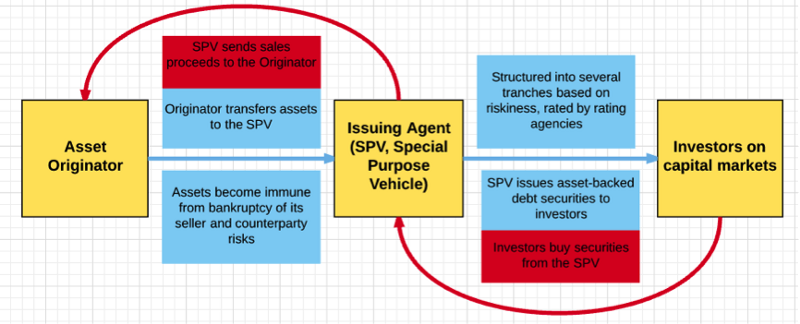Paving the way from securitization to tokenization
The development of computer technology affects all fields of human activity. Obviously, such changes also affect and transform processes in the financial services market. One such innovation in its time was the securitization of financial markets. The term “securitization” proliferated worldwide in the 1980s, when the first market bonds were issued. As technology develops, the old securitization model no longer meets all market demands.
Let’s figure out how classic securitization works and look at the terminology. Securitization is the issuance of debt securities backed by a pool of standardized assets of a single type. Thanks to securitization, low-liquidity assets (for example, bank mortgages which generate cash flows over decades) are generally converted into higher liquidity security instruments, to be traded on markets and over-the-counter.

To simplify, the securitization process consists of four consecutive steps. The originator, who owns assets, collects them in a pool, standardizes them and transfers the pool to a legal entity (special purpose vehicle, SPV) established specifically to issue bonds. Because of this, the assets are not exposed to the risk of bankruptcy of the originator bank and to counterparty risk. Then, the SPV structures the assets within the pool into several tranches (usually according to the level of risk) and issues securities — bonds — which are backed by the cash flows generated by the underlying assets. As a rule, rating agencies like Standard & Poor’s assign a rating to every tranche, where the rating of each tranche may be higher or lower than the rating of others, depending on the quality of the asset pool. Thereafter the SPV sells securities, usually to institutional investors, where the originator itself may also become an investor in a tranche. Finally, the SPV transfers the proceeds to the originator.
To simplify, the securitization process consists of four consecutive steps. The originator, who owns assets, collects them in a pool, standardizes them and transfers the pool to a legal entity (special purpose vehicle, SPV) established specifically to issue bonds. Because of this, the assets are not exposed to the risk of bankruptcy of the originator bank and to counterparty risk. Then, the SPV structures the assets within the pool into several tranches (usually according to the level of risk) and issues securities — bonds — which are backed by the cash flows generated by the underlying assets. As a rule, rating agencies like Standard & Poor’s assign a rating to every tranche, where the rating of each tranche may be higher or lower than the rating of others, depending on the quality of the asset pool. Thereafter the SPV sells securities, usually to institutional investors, where the originator itself may also become an investor in a tranche. Finally, the SPV transfers the proceeds to the originator.
The classic securitization process described above has serious flaws, the first of which is the high time consumption and cost of the process. The preparation for such a transaction often takes at least six months to a year, while the cost of services to carry it out ranges from 500 000 to millions of dollars, making it unattractive to many originators. This happens because the securitization process requires a detailed audit of the asset pool and agreements with various parties under conditions of asymmetric information, as well as a heterogeneous structure of asset data. This happens because the securitization process requires a detailed audit of the asset pool and agreements with various parties under conditions of asymmetric information as well as a heterogeneous structure of asset data.[MS1]
In addition, the lack of full transparency in the various stages of securitization hinders accurate risk assessment and enables fraud (for example, issuing concurrent mortgages on the same asset, or the inclusion of non-existent assets). Inadequate control of the credit pool may provoke a default on the bonds issued. The problems are exacerbated by the proliferation of low-quality auditing and rating which contributed to the sub-prime mortgage crisis.
On top of that, tightening regulation draws parties towards more transparency and structuring of information, which further complicates the process of securitization. [2]
Blockchain provides a powerful solution to all of those challenges:
Creating a single and standardized source of information instead of multiple data silos across different entities. This makes information sharing easier and streamlines the process at different stages, reducing costs and time consumption.
It improves price discovery and liquidity by making security prices more accurately reflect true value.
An immutable trail of changes enables instant audit during all stages of the process, starting from loan origination to changes of ownership in the secondary market for securities. Immutability significantly cuts due diligence costs.
Disintermediation and simultaneous recording of data into blockchain boosts the speed and reduces costs as well.
We believe that blockchain will enable smooth integration of all parties involved in securitization, their data and cash flows. The advantages of blockchain will contribute to faster, cheaper and more transparent securitization. This will significantly increase the volume of the securitization market and make it more efficient. A great variety of new asset classes will now be available for securitization, and at much higher frequency.
BANKEX is building its Proof-of-Asset Protocol of liquidity to deliver this service, and transform capital markets. For more information, visit the page devoted to how the Proof-of-Asset Protocol works:
More information is available at:
Website: https://bankex.com/
Telegram: https://t.me/bankex
Facebook: https://www.facebook.com/BankExchange/
GitHub: https://github.com/BankEx
Slack: http://bit.ly/slack-bankex